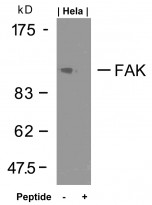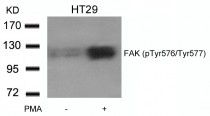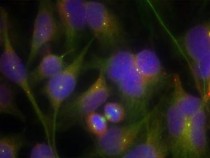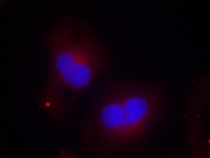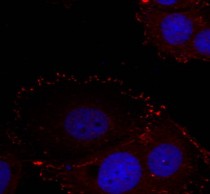ARG30203
Phospho FAK Antibody Panel
Cancer antibody; Cell Biology and Cellular Response antibody; Immune System antibody; Signaling Transduction antibody
Component
| Cat No | Component Name | Host clonality | Reactivity | Application | Package |
|---|---|---|---|---|---|
| ARG51136 | anti-FAK antibody | Rabbit pAb | Hu, Ms, Rat | ICC/IF, IHC-P, WB | 50 μl |
| ARG51706 | anti-FAK phospho (Tyr397) antibody | Rabbit pAb | Hu, Ms, Rat | IHC-P, WB | 50 μl |
| ARG51831 | anti-FAK phospho (Tyr576 / Tyr577) antibody | Rabbit pAb | Hu, Ms, Rat | ICC/IF, WB | 50 μl |
| ARG51624 | anti-FAK phospho (Tyr925) antibody | Rabbit pAb | Hu, Ms, Rat | ICC/IF, WB | 50 μl |
| ARG65351 | Goat anti-Rabbit IgG antibody (HRP) | Goat pAb | Rb | ELISA, IHC-P, WB | 50 μl |
Overview
| Product Description | Focal adhesion kinase (FAK) is a widely expressed cytoplasmic protein tyrosine kinase involved in integrin-mediated signal transduction. It plays an important role in the control of several biological processes, including cell spreading, migration, and survival. Activation of FAK by integrin clustering leads to autophosphorylation at Tyr397, which is a binding site for the Src family kinases PI3K and PLCγ. Recruitment of Src family kinases results in the phosphorylation of Tyr407, Tyr576, and Tyr577 in the catalytic domain, and Tyr871 and Tyr925 in the carboxy-terminal region of FAK. Schaller, M.D. et al. (1994) Mol Cell Biol 14, 1680-8. Cobb, B.S. et al. (1994) Mol Cell Biol 14, 147-55. Parsons, J.T. et al. (2000) Oncogene 19, 5606-13. Schlaepfer, D.D. et al. (1994) Nature 372, 786-791. |
|---|---|
| Target Name | FAK |
| Alternate Names | Phospho FAK antibody; Phospho Focal adhesion kinase antibody; FAK antibody; FAK phospho (Tyr925) antibody; FAK phospho (Tyr397) antibody; FAK phospho (Tyr576 / Tyr577) antibody |
Properties
| Storage Instruction | For continuous use, store undiluted antibody at 2-8°C for up to a week. For long-term storage, aliquot and store at -20°C or below. Storage in frost free freezers is not recommended. Avoid repeated freeze/thaw cycles. Suggest spin the vial prior to opening. The antibody solution should be gently mixed before use. |
|---|---|
| Note | For laboratory research only, not for drug, diagnostic or other use. |
Bioinformation
| Gene Full Name | Phospho Focal adhesion kinase (FAK) Antibody Panel |
|---|---|
| Research Area | Cancer antibody; Cell Biology and Cellular Response antibody; Immune System antibody; Signaling Transduction antibody |
Images (8) Click the Picture to Zoom In
-
ARG51136 anti-FAK antibody WB image
Western Blot: extracts from HeLa cells stained with anti-FAK antibody ARG51136 and the same antibody preincubated with blocking peptide.
-
ARG51624 anti-FAK phospho (Tyr925) antibody WB image
Western Blot: extracts from 293 cells stained with anti-FAK (phospho Tyr925) antibody ARG51624 (Lane 2) and the same antibody preincubated with blocking peptide (Lane1).
-
ARG51706 anti-FAK phospho (Tyr397) antibody WB image
Western Blot: extract from 293 cells untreated or treated with EGF stained with anti-FAK (phospho Tyr397) antibody ARG51706
-
ARG51831 anti-FAK phospho (Tyr576 Tyr577) antibody WB image
Western Blot: extracts from HT29 cells untreated or treated with PMA stained with anti-FAK (phospho Tyr576 Tyr577) antibody ARG51831.
-
ARG51136 anti-FAK antibody IHC-P image
Immunohistochemistry: paraffin-embedded human breast carcinoma tissue stained with anti-FAK antibody ARG51136 (left) or the same antibody preincubated with blocking peptide (right).
-
ARG51136 anti-FAK antibody ICC/IF image
Immunofluorescence: methanol-fixed HeLa cells stained with anti-FAK antibody ARG51136.
-
ARG51624 anti-FAK phospho (Tyr925) antibody ICC/IF image
Immunofluorescence: methanol-fixed HeLa cells stained with anti-FAK (phospho Tyr925) antibody ARG51624.
-
ARG51831 anti-FAK phospho (Tyr576 Tyr577) antibody ICC/IF image
Immunofluorescence: methanol-fixed HeLa cells stained with anti-FAK (phospho Tyr576 Tyr577) antibody ARG51831.
